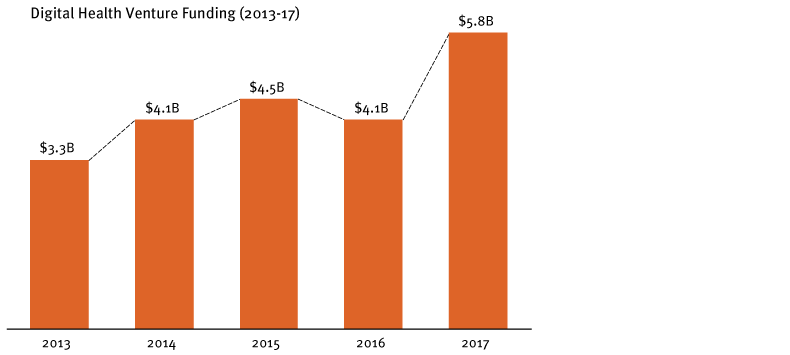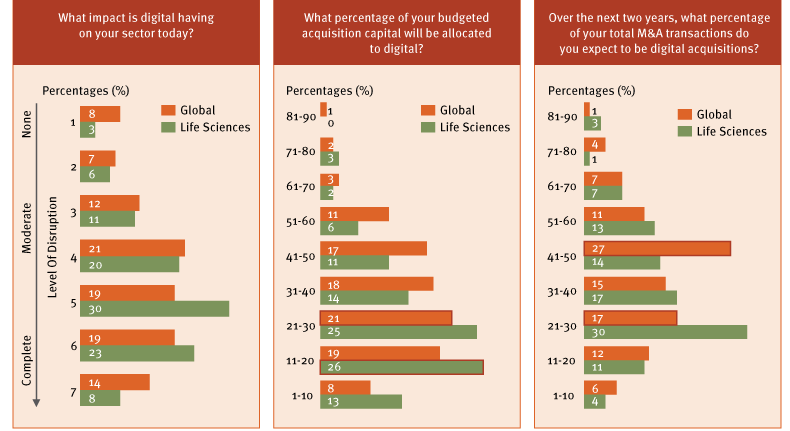Digital Deals And Life Sciences: Avoiding Death By A Thousand Pilots
Executive Summary
EY executive survey yields insights into how digital technology is helping drive biopharma deal strategy and aiding companies to meet competitive challenges.
For some years now, the application of digital technology in health care has promised to advance patient-focused outcomes to reduce costs across a very fragmented ecosystem. To their credit, life sciences companies have made investments in this area, to some success. But they have yet to move beyond pills and apps at the pilot stage to fully embrace a business model geared to an at-scale state of convergence between health care and digital. Instead, life sciences companies have largely opted to acquire or partner with technology innovators for point solutions.
EY’s 2018 Digital Deal Economy Study surveyed 900 global executives, including more than 70 in life sciences. Its findings portray how digital technology increasingly drives the strategy behind biopharma deal-making activity.Several observations emerged, demonstrating the role digital is playing to meet competitive challenges in this highly regulated, competitive and fragmented industry.
Beset by rising costs and administrative inefficiencies, patients and payers are demanding action from the health care industry. Over the past 10 years, digital technologies have enabled the gathering and exchange of massive amounts of health-related data to address previously unanswerable questions along with targeted and timely services at the personal-care level. These new capabilities are attracting the interest of a number of big pharma players. In February, Roche doubled down on its investment in precision medicine following its investment in Foundation Medicine Inc. in 2015 by acquiring Flatiron Health Inc. for $1.9 billion. (Also see "Deal Watch: Roche Goes All-In On Real-World Data With Flatiron Acquisition" - Scrip, 19 Feb, 2018.) The acquisition of this oncology focused electronic health record (EHR) company gives Roche access to real-word evidence (RWE) data it hopes to use to inform better clinical trial design and outcomes, cementing its place as a leader in oncology therapeutics.
Other large pharma companies are turning to digital start-ups looking to up-end traditional therapeutic approaches, evidenced by Novartis AGs recent digital medicine partnership deal with Pear Therapeutics Inc. to develop new mobile apps that provide FDA-approved interactive digital programs for patients with schizophrenia and multiple sclerosis. (Also see "Novartis Teams With Pear Therapeutics In Neurological Digital Health Pact" - Scrip, 1 Mar, 2018.) The recent announcement of an alliance between an online retailer, an insurance conglomerate and an investment bank also has a disruptive potential to the complex and fragmented health care ecosystem. (Also see "Mysterious Amazon/Berkshire/JPMorgan Partnership Could Disrupt Health Care, Pharma" - Scrip, 30 Jan, 2018.)
Two major strategic questions emerged from our survey, as follows:
Where does the life sciences industry need to focus to benefit from the convergence of health care, digital and services?
Having tried brand-focused point solutions, life sciences executives should consider platform strategies that would embed their digitally enabled therapeutic solutions into today’s value-driven ecosystem. This may include complementary services powered by data and analytics, as well as partnerships with other players, such as risk-bearing providers and payers. The industry can leverage its implicit firepower to design business models in which all parties win, including patients. Using acquisitions, joint ventures and other risk-sharing partnerships with health care technology players can generate a differentiated market position and help redefine life sciences companies’ role in the new health care ecosystem. This may position them as solution providers and thus change the perception of such firms from being contributors to health care costs to being essential players in helping deliver improved health outcomes.
EY’s Digital Deal Economy survey findings also reported that more than 60% of life sciences companies expect to look externally, through M&A, outsourcing, alliances and joint ventures to drive their digital strategy.Digital health venture funding has continued to grow at a CAGR of 15% over the last five years (see Exhibit 1) to $5.8 billion in 2017, according to Rock Health and EY analysis. In comparison the life sciences M&A for therapeutic assets totaled $200 billion, other analyses found. Fueled with the provisions of the tax reform, such as the lowered corporate tax rate on earnings and ability for a one-time offshore repatriation in 2018, life sciences companies are expected to pursue deals at a higher rate. This war chest will allow them to bet increasingly on digital technology strategies, seek scale to combat payer pressure and customer consolidation in a fragmented landscape, and pilot new value-driven business models.
Yet, ever-increasing valuations will require a rigorous strategic and financial rationale, reinforcing the need for life sciences companies to deploy their corporate development deal savvy toward digital assets. Projecting from the statistics about participation in the Healthcare Information and Management Systems Society (HMSS) 2018 Annual Convention (reported by Mark Anderson in GLG Conference on HIMSS 2018 Outlook: Trends to Watch), we expect the funding to continue to flow to primarily six areas: (1) analytics and big data, (2) health care consumer experience, (3) digital medical devices, (4) telemedicine, (5) personalized medicine, and (6) population health management.
We also expect this trend to accelerate with the impending next wave of mobile technology or 5G capability to allow for much more efficient and prompt device-to-device communication, thus making the medical Internet of Things (mIoT) an operational reality. In the upcoming decade, the medical device industry will be differentiated largely by consolidating mIoT into its product design.

Life sciences companies can leverage this transformative health care technology wave by creating interconnected ecosystems and exploring promising technology assets from a pool of thousands as a source of growth and innovation to insert their products and solutions into the value chain. They can then integrate digital health care technology to augment an existing product’s revenue, or bring in health care technology-enabled services to supplement the market position of a traditional pharma or medical device product.
How are life sciences companies deploying capital strategies and M&A to further digital transformation today?
Herein lies the dilemma. Although life sciences companies view digital as being more disruptive to their sector than their peers in other industries, life sciences companies plan to allocate relatively less of their budgeted acquisition capital to digital and consequently expect fewer of their M&A transitions in the next two years will be digital related (see Exhibit 2).

Relative to peers in other industries, life sciences respondents consider their customer-facing digital capabilities in digital customer experience, mobile application, Internet of Things and advanced analytics as market leading. However, fewer life sciences companies generally view their applications of digital to talent and skills, sales and marketing, manufacturing, back office, and automation and robotics as market leading relative to their peers in other industries.
The life sciences industry is in a period of experimentation and is willing to make one-off bets on at-scale assets to help embed these capabilities into its therapeutic business models. Those life sciences companies that apply their M&A skills to the digital space will gain even more through greater operational agility and competitiveness as they seek market-disrupting opportunities.
Arda Ural, PhD, is a principal with Ernst & Young LLP’s Transaction Advisory Services and leads Operational Integration and Divestitures for Life Sciences. He can be reached at [email protected]. Christina Lo also contributed to this article and is a senior manager with Ernst & Young LLP Transaction Advisory Services.
The views reflected in this article are the views of the author and do not necessarily reflect the views of the global EY organization or its member firms.